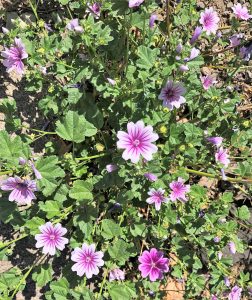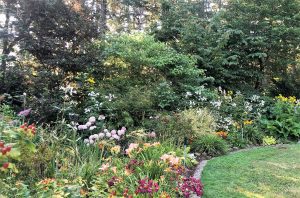
A few weeks ago, I took a day trip to the tiny town of Elkton, Oregon to visit butterflies. The Elkton Community Education Center includes Elkton’s library, community meeting area, and other historic buildings, but the Butterfly Pavilion, a netted hoop house that shares the open parkland on the Umpqua River was my goal. But I didn’t know that the most magical part of my journey wouldn’t be in the pavilion.
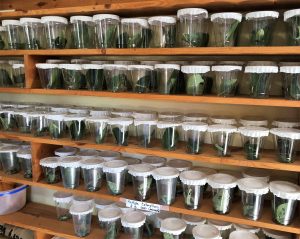
The Butterfly Pavilion was lovely, with fully grown butterflies flittering about the mass of head-high pink Joe Pye weed flowers. Blue-flowering verbena stalks sheltered caterpillars. The plants were supplemented by bouquets of other nectar sources like yarrow, Queen Ann’s lace, and black-eyed Susan. I was reminded that late-flowering plants in the garden sustain all kinds of butterflies. Especially those long-distance travelers – the monarchs.
On one wall of the pavilion hung a series of inch-long pale green monarch chrysalises. A knowledgeable volunteer – an enthusiastic high-schooler – showed me the close-up pattern of golden dots that adorned each. They caught the sunlight as if molten drops had arrayed themselves over the jade-green surface. I was told this might be the reason monarchs have their regal name.

These monarchs, their eggs gathered from the nearby plants in the park land, are being raised in optimal conditions for them to migrate. According to a recent University of Chicago study, commercial rearing in response to diminishing monarch numbers has not been as successful as hoped for. More study on what triggers the impulse to migrate needs to happen. But screened areas, open to the weather like this one in Elkton, are the best.
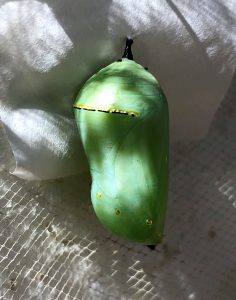
However, most butterflies we see in our gardens are not long-distance travelers, but live from one week to several months within a few hundred yards of where they first flew. (The US has 780 species—twenty butterflies and moths are endangered.) Also, unlike monarchs that rely on various species of milkweed, many others, such as painted ladies, can feast on a wide variety of plants, some hosting caterpillars and others as nectar source for butterflies. So, we can all help by adding late-season flowers to our gardens.
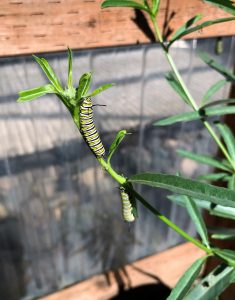
The first step is to choose plants not subject to pesticides. And the best way to do that is to plant seeds in your own greenhouse. Many late-season perennials and annuals can be started now and planted out in your garden in fall if conditions permit, or they can be continued in the greenhouse for early spring planting. This includes natives for your region, many of which can only be grown from seeds.
And the holes that very hungry caterpillars produce? Be proud. It means you are supporting wild things, right there in your own back yard. Protecting food plants such as cabbage and broccoli with a fine netting keeps the critters off without resorting to pesticides.
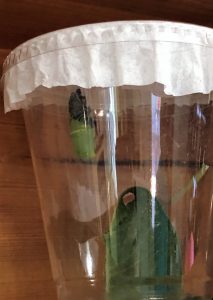
In Elkton, the magic happened for me when that same high school student invited me to enter the office shared by the head gardener. There, hundreds of plastic cups lined many shelves. Each had a caterpillar in its last instar, along with bright green milkweed leaves. They ate so much, they were fed and cleaned daily. The top shelf held the two oldest, now hanging head down, forming a j-shape. The volunteer told me that within a short time, they would shed their final skin and pupate into that pale satin green capsule. I certainly didn’t think I would get to see that.
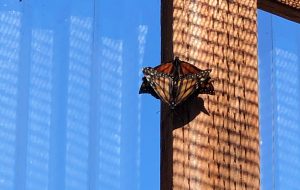
Then one started wiggling madly. The outer skin shuffled upward, moving from the hanging head on up to the attached back end. At the top, the skin dropped off to the bottom of the cup. Within a couple of minutes, it was all over. Now, instead of the distinctly patterned caterpillar skin, a shining green and gold-flecked capsule hung there instead. Then, the second caterpillar started the same violent wiggles and bumping, and off everything came. There it hung, displaying the same gorgeous green. After the chrysalises hardened, they would be transported back to the outdoor enclosure.

Word that it was happening had spread. Folks working at the Community Center came running in to see it. It’s that special, even for those who work with butterflies.
And it’s that special in our gardens – magic happens right under our noses. I came away from Elkton determined to add more late-seasonals to my garden and keep a bit of wildness, some brush or rocks, in some corner of my yard, so that butterflies and moths have a chance to overwinter undisturbed.
